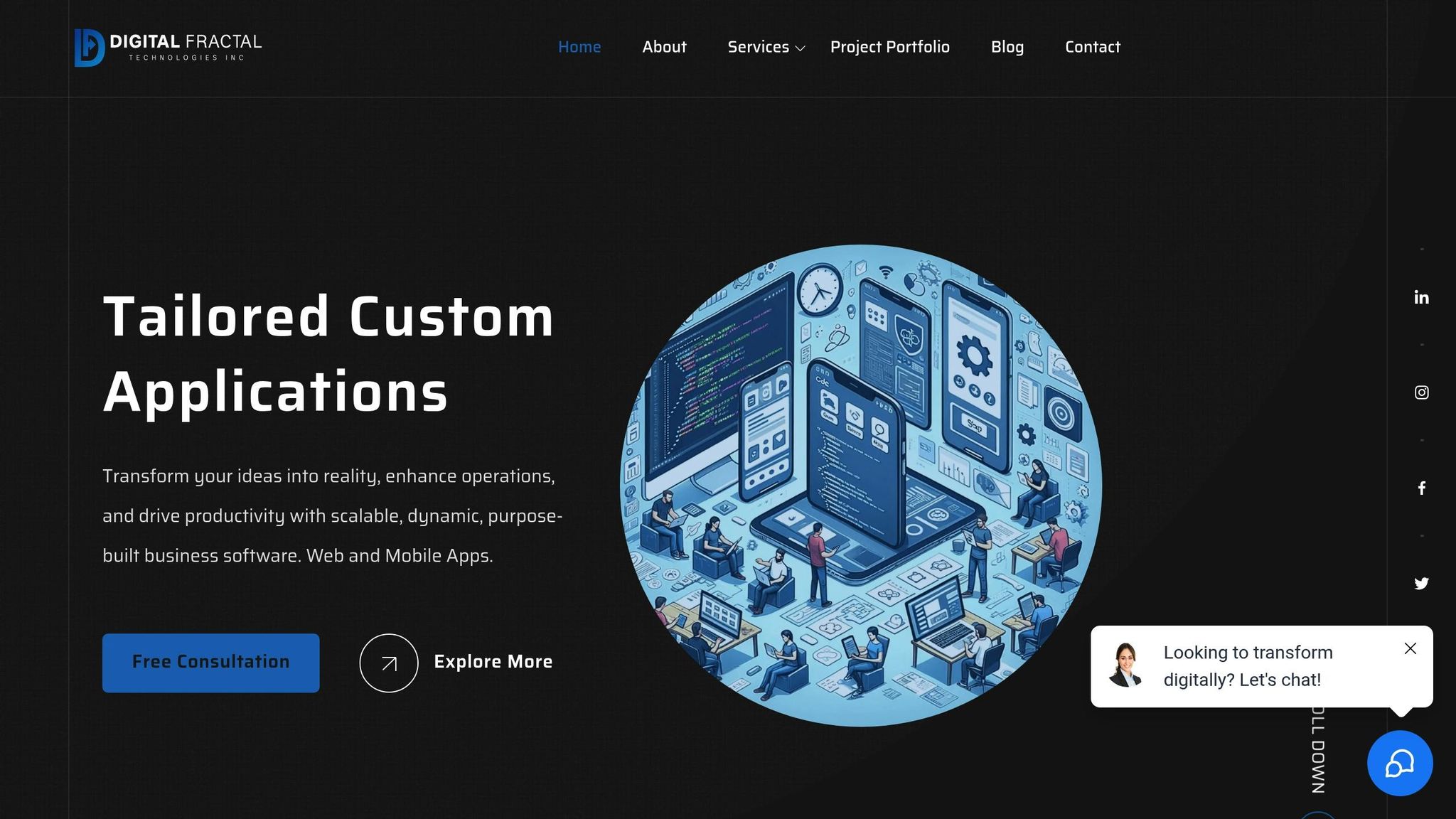
AI Implementation FAQ for Business Leaders
AI is reshaping how Canadian businesses operate. From improving logistics in vast regions to addressing talent shortages, AI is solving real-world challenges across industries like healthcare, construction, and manufacturing. But where do you start? Here’s what you need to know:
- Align AI with Goals: Focus on specific problems AI can solve, like reducing costs or improving customer service.
- Assess Readiness: Evaluate your data, technical infrastructure, and team skills before diving in.
- Start Small: Pilot projects with clear outcomes are key to testing AI’s potential while minimizing risks.
- Overcome Challenges: Tackle issues like poor data quality, tech integration, and talent shortages with strong governance and training.
- Long-Term Success: Build ethical systems, train your team, and continuously monitor AI performance.
Canadian businesses adopting AI are seeing faster software development, better customer experiences, and reduced costs. The time to act is now – start with small, focused steps and scale gradually.
AI Implementation Framework: A Guide for Organizational Leaders in 2024
Key Steps for AI Adoption
Adopting AI successfully requires a well-thought-out plan that aligns technology with your business needs, evaluates readiness, and demonstrates value through controlled testing. A structured approach ensures that AI implementation delivers meaningful results.
Aligning AI with Business Goals
To make AI work for your business, it’s crucial to tie it directly to your objectives. Instead of asking, “What can AI do?” focus on, “What specific problems can AI solve for us?”
Start by identifying your top challenges. Maybe your customer service response times are lagging, demand forecasting is inaccurate, or manual data processing is draining resources. Each issue should connect to measurable business outcomes, like reducing costs, improving customer satisfaction, or boosting revenue.
Set clear, measurable goals tied to these challenges. For instance, you might aim for faster response times or higher first-contact resolution rates. These benchmarks not only justify the investment in AI but also provide a way to track progress.
Think long-term, too. AI projects that align with your broader business strategy – like a five-year growth plan – are more likely to gain support. For example, if your company aims to expand into new markets, AI tools that enhance scalability or provide market insights can add ongoing value.
Document these goals and connections in a detailed business case. This step is essential for securing executive buy-in and maintaining focus throughout the process. Once your objectives are clear, assess your current capabilities to determine if you’re ready to integrate AI.
Conducting Readiness Assessments
Before jumping into AI implementation, take a hard look at your current setup. This evaluation should cover three main areas: data infrastructure, workforce skills, and operational readiness.
Data infrastructure is the foundation of any AI system. Review how you collect, store, and manage data. Is your data organized, accessible, and consistent? If your data is scattered across departments in silos, it could hinder AI’s effectiveness. Assess the quality of your data – check for completeness, accuracy, and consistency.
Next, evaluate your technical infrastructure. Can your systems handle the computational demands of AI? Do you have enough cloud storage and processing power? Don’t overlook data security, especially given Canada’s privacy laws and industry-specific regulations.
Workforce readiness is equally important. Assess your team’s current technical skills and identify any gaps. While not everyone needs to be an AI expert, key staff should understand how AI works and its limitations. Also, consider your organization’s ability to adapt. New technologies often require changes to existing workflows, and a strong change management strategy can make the transition smoother.
Lastly, examine your operational readiness. Does your team embrace data-driven decision-making? Are there processes in place for testing and implementing new technologies? Companies with a culture of experimentation and solid project management practices are often better positioned for AI success.
Using a readiness scorecard or similar tool can help you measure where you stand and prioritize what needs improvement. Once you’re confident in your readiness, it’s time to test the waters with pilot projects.
Starting with Pilot Projects
Pilot projects are a great way to test AI’s potential while keeping risks and costs under control. The trick is to pick a project with a clear, manageable scope and measurable outcomes.
Choose pilot projects that are impactful enough to demonstrate AI’s value but small enough to handle easily. Examples include automating customer inquiry classification, improving demand forecasting, or streamlining document processing – tasks where the inputs and expected results are well-defined.
Set realistic timelines and allocate resources for the pilot without disrupting your day-to-day operations. Establish milestones to track progress and make adjustments as needed.
Even though pilots are small-scale, design them with scalability in mind. The systems and processes you develop should be flexible enough to expand later. Keep stakeholders informed throughout the pilot to maintain support and address any concerns early.
Prepare for different outcomes by creating contingency plans. If the pilot doesn’t go as expected, you’ll need to pivot quickly. Collect feedback from users and provide training to ensure the AI system is practical and easy to use. Use the insights gained during the pilot to refine your overall AI strategy, keeping in mind that successful AI adoption is an iterative process.
Common AI Implementation Challenges
Once Canadian businesses move beyond pilot projects and begin scaling AI, they often face a new set of challenges. Even with solid preparation, the transition from small-scale tests to full-scale operations can reveal unexpected obstacles. Identifying these issues early can help you develop strategies to keep your AI initiatives on track.
Data Quality and Governance
The success of AI systems depends heavily on the quality of the data they use. Many organizations discover that their data isn’t AI-ready when they begin building models.
Inconsistent data can result in flawed insights. For instance, if one department records a customer’s location as "Toronto, ON" and another uses "Toronto, Ontario", AI systems may struggle to make accurate connections. Similarly, missing information, duplicate entries, or outdated records can lead to unreliable predictions and skewed results.
To address these issues, strong data governance frameworks are essential. Clear policies for data collection, storage, and usage should align with Canada’s Personal Information Protection and Electronic Documents Act (PIPEDA) and relevant provincial laws. Appointing data stewards to manage quality standards and resolve issues quickly can further enhance reliability.
Tracking data lineage – understanding where your data comes from and how it’s transformed – can help troubleshoot model performance and ensure compliance with regulations. Routine practices like data cleaning, validation, and audits are also crucial for maintaining quality over time.
Technology Integration Issues
Integrating AI into existing systems is rarely straightforward, especially when legacy infrastructure is involved. Using API layers to connect older systems with AI tools can avoid the need for costly replacements while ensuring access to necessary data.
Scalability is another common hurdle. Solutions that work well in a pilot phase may falter under the demands of full-scale operations. Cloud-based platforms, which adjust computing resources as needed, can help manage costs and maintain performance.
Real-time processing is often critical for applications like fraud detection or dynamic pricing. However, these demands can strain existing IT infrastructure. Conducting thorough performance tests and preparing backup systems can help prevent disruptions.
AI also introduces new security challenges. With access to sensitive data across multiple platforms, these systems can create vulnerabilities. Adopting robust security measures, such as zero-trust models and strong encryption for data in transit and at rest, can help mitigate risks.
As you tackle these technical challenges, building a skilled team is equally important to ensure AI success.
Addressing the Talent Gap
A shortage of AI expertise remains a significant obstacle for many Canadian businesses. Building internal capabilities through upskilling and hybrid teams can help bridge the gap.
Training your current employees in AI fundamentals and data analysis is often a smart move. They already understand your business and its unique needs, which gives them a head start in applying AI effectively.
Introducing AI literacy programs for non-technical staff can also create a more cohesive approach. When everyone on your team understands what AI can and cannot do, it helps set realistic expectations and supports smarter decision-making.
Collaborating with Canadian universities and colleges through co-op programs is another way to address long-term talent needs. Internal mentorship initiatives can also encourage knowledge sharing and create a culture of continuous learning, where employees feel empowered to experiment and innovate.
Managing Ethics and Regulations
Scaling AI also requires a continued focus on ethics and compliance. As systems grow more complex, it’s critical to ensure they remain fair, unbiased, and respectful of privacy.
Bias in AI models is a persistent challenge that demands ongoing attention. Regular testing with diverse datasets and audits can help identify and correct discriminatory patterns. For added transparency, use models that provide clear explanations for their decisions – especially in sensitive areas like hiring, credit approvals, or healthcare.
Privacy compliance goes beyond protecting data. It also involves how AI systems use and share personal information. Under PIPEDA and provincial laws, obtaining meaningful consent for data use and allowing individuals to access or correct their information are key requirements. Designing AI systems with privacy in mind and implementing strong access controls can help meet these standards.
As regulations evolve, staying informed about federal and provincial AI governance is essential. Keeping up with new rules can help you adapt quickly and avoid compliance issues.
Engaging with stakeholders – whether they’re customers, employees, or community groups – can also uncover potential concerns early. Open communication about your AI practices and safeguards builds trust and helps ensure your operations remain ethical and compliant.
Benefits of AI-Driven Software Development
AI is delivering measurable advantages for Canadian businesses, particularly in software development and operations. Companies that effectively integrate AI often experience faster project timelines, improved quality, and cost savings. Beyond the technical perks, these gains can reshape how businesses cater to their customers and manage day-to-day operations, boosting both efficiency and customer satisfaction.
Faster Development Cycles
AI-powered tools are significantly speeding up how software is created and deployed. Features like code generation handle repetitive programming tasks, freeing developers to focus on solving complex challenges and driving innovation.
Modern AI tools also streamline processes by generating unit tests, spotting bugs early, and optimizing code. These automation capabilities cut down on manual tasks, allowing projects to move forward faster without sacrificing quality.
Automated testing is another game-changer. It runs comprehensive test suites simultaneously, catching potential integration issues far quicker than traditional manual testing. This means software updates can go live faster while still meeting high-quality standards.
AI’s role doesn’t stop at development – it extends to deployment and maintenance. Real-time monitoring systems powered by AI can automatically scale resources during peak usage and detect issues before users are affected. This proactive approach reduces downtime and minimizes the need for manual intervention, making operations smoother and more reliable.
For businesses spread across Canada’s time zones, AI tools ensure progress continues even after work hours. Automated processes, like overnight builds and testing, keep projects moving forward, so teams can review results the next day.
Better Customer Experiences
AI is helping businesses better understand and serve their customers by offering deeper insights and personalized interactions. With predictive analytics, companies can anticipate customer preferences and behaviours, allowing them to address needs before they even arise.
Personalization is another key advantage. Custom recommendation engines suggest products or services tailored to individual customer histories and preferences. This creates experiences that feel personal and engaging, boosting both satisfaction and loyalty.
AI-powered chatbots and virtual assistants enhance customer support by providing instant answers to common questions, even outside regular business hours. These systems efficiently handle routine inquiries while escalating more complex issues to human representatives, ensuring timely and accurate assistance.
Another standout feature is dynamic content optimization, where websites and apps adjust their layout and messaging based on user behaviour. This creates a seamless, intuitive experience that aligns with how each customer interacts with the platform.
For Canadian businesses serving both English and French-speaking audiences, AI-powered language processing ensures smooth translation and localization. This enables consistent service quality across languages without doubling development efforts.
Lower Costs and Higher Efficiency
Adopting AI often leads to financial benefits in a short time. By optimizing resources, businesses can allocate computing power, staff, and infrastructure more effectively, based on actual demand rather than estimates.
Automating workflows reduces errors and frees employees to focus on strategic tasks. For instance, routine tasks like data entry, report generation, and basic analysis can run automatically, allowing staff to invest their time in work that requires human insight and creativity.
AI also supports predictive maintenance, helping businesses identify potential equipment issues before they lead to costly failures. This approach minimizes emergency repair expenses and extends the lifespan of essential infrastructure.
In a country with seasonal temperature swings like Canada, AI-driven energy management is especially valuable. Smart systems can adjust heating, cooling, and lighting based on occupancy and weather forecasts, cutting utility costs significantly.
Lastly, AI scalability enables businesses to handle growing workloads without a proportional increase in staffing costs. As demand rises, AI systems can manage more transactions, serve additional customers, and process larger datasets, all while keeping operational costs under control.
sbb-itb-fd1fcab
Digital Fractal Technologies Inc: AI Solutions for Canadian Enterprises

Digital Fractal Technologies Inc, headquartered in Edmonton, Alberta, brings over 20 years of expertise to Canadian businesses seeking to integrate AI into their operations. The company has earned a reputation as a trusted partner, helping organizations across Canada leverage artificial intelligence to gain a competitive edge.
With 45% of their work dedicated to AI, Digital Fractal focuses on crafting solutions that address the specific challenges Canadian enterprises face. Their tailored applications are designed to fit seamlessly into existing business ecosystems while adhering to data sovereignty principles. Let’s explore how Digital Fractal applies its expertise to meet these needs.
Custom AI-Driven Software Development
Digital Fractal specializes in delivering comprehensive AI solutions, covering everything from data engineering to advanced machine learning and computer vision. Instead of offering generic products, they focus on designing custom solutions that align with each client’s unique goals.
Their automation tools streamline workflows by reducing manual processes, cutting operational costs, and ensuring smooth integration with existing systems. For businesses looking to modernize, their legacy app migration services not only update outdated systems but also incorporate advanced AI capabilities.
The company also develops large language models (LLMs), image and video processing systems, and intelligent AI agents that continuously learn and adapt based on organizational data.
Industry-Specific Applications
Digital Fractal caters to a wide range of industries, including energy, construction, heavy industry, public services, logistics, manufacturing, and healthcare.
- In the energy sector, their vision-based AI tools help monitor equipment performance, a crucial factor in maintaining Canada’s energy infrastructure.
- Healthcare organizations benefit from video analytics systems that improve patient monitoring and operational workflows.
- For manufacturing clients, predictive analytics tools enhance production efficiency, helping businesses stay competitive.
Meeting Canadian Standards
Operating from their Edmonton base, Digital Fractal ensures all solutions comply with Canadian standards and data sovereignty requirements. This commitment guarantees that sensitive business information remains secure and adheres to privacy laws and industry-specific regulations.
Their enterprise AI consulting services also assist businesses in navigating the complex regulatory landscape, providing guidance on how AI adoption impacts compliance with Canadian privacy and legal frameworks.
Best Practices for Long-Term AI Success
For Canadian businesses, the road to success with AI lies in adopting practices that are ethical, sustainable, and built for the long haul. The goal is to create systems that not only adapt to changing needs but also provide ongoing value.
Building Ethical and Transparent AI Systems
For AI to be trusted, its decision-making processes must be clear and easy to understand. Every decision made by AI should be documented and explainable, and all processes should align with PIPEDA regulations. Transparency is key – clearly outline how data is used and ensure explicit consent is obtained when handling sensitive information.
Regular audits are essential. Use diverse datasets to identify biases and address them promptly. Bringing together a mix of internal experts from different departments and external advisors can help ensure an objective review of your AI systems.
Consider forming an AI ethics committee within your organization. This group should include team members from various departments, legal experts familiar with Canadian regulations, and external advisors who can provide fresh perspectives. Their role is to ensure accountability and guide ethical AI practices.
Once a strong foundation of ethics and transparency is in place, focus on preparing your team to keep up with the fast-paced world of AI advancements.
Ongoing Training and Updates
Employee training should be a continuous process, covering new AI frameworks, system updates, and security measures. Regularly monitor your AI models to detect issues like model drift and retrain them as needed.
Different teams require tailored training. Technical teams need to stay updated on the latest AI frameworks, integration techniques, and security protocols. Business users should learn how to interpret AI outputs, understand system limitations, and recognize when human intervention is necessary. Management teams must stay informed about AI governance, regulatory changes, and strategic opportunities.
Security is another critical area. AI systems are increasingly targeted by cyberattacks aiming to manipulate results or steal data. Regular security assessments and updates are non-negotiable to safeguard your systems against these threats.
Integrating ongoing training with performance monitoring allows for continuous improvement and ensures your AI systems remain effective and secure.
Monitoring and Improvement
Success in AI isn’t just about technical metrics like accuracy or speed. It’s about how well the system supports your business goals. Canadian organizations should define key performance indicators (KPIs) that link AI performance to tangible outcomes like revenue growth, customer satisfaction, and operational efficiency.
Regular performance reviews should go beyond technical results. Examine how well the system serves different user groups and business scenarios. This includes identifying unexpected behaviours, addressing performance issues, and finding areas for improvement.
Set up formal feedback channels to capture insights from employees who work closely with AI systems. These team members often spot patterns or problems that automated monitoring might miss.
Flexibility is crucial as businesses evolve. Whether expanding into new markets, integrating additional data sources, or refining algorithms to meet changing needs, your AI systems should grow alongside your organization. This adaptability ensures that AI continues to meet both current and future challenges.
Finally, maintain thorough documentation of system changes, performance data, and lessons learned. These records are invaluable for guiding future improvements, avoiding past mistakes, and making informed decisions about AI investments. By following these disciplined practices, Canadian businesses can ensure AI remains a reliable tool for driving innovation and efficiency.
Conclusion
For Canadian businesses, integrating AI is no longer just an option – it’s a necessity in today’s competitive landscape. While moving from initial exploration to full-scale deployment requires careful planning, the potential benefits are immense for organizations that take a deliberate approach.
The secret to successful AI adoption? Start small and scale thoughtfully. Launch pilot projects that align with your business goals, ensure your data is accurate and reliable, and invest in training your team. AI has the power to reshape operations and enhance customer experiences when implemented with care.
Canada offers unique advantages for businesses adopting AI. With regulations like PIPEDA promoting transparency and accountability, Canadian organizations are well-positioned to lead in building trustworthy and ethical AI systems. This regulatory framework provides a solid foundation for responsible innovation.
Of course, challenges such as data management and a shortage of skilled professionals can’t be ignored. However, these hurdles can be tackled by collaborating with experienced partners and adhering to proven best practices. Having the right expertise on your side is crucial.
Digital Fractal Technologies Inc is ready to guide Canadian businesses through every step of their AI journey. With the right partner, achieving long-term success becomes far more attainable.
The time to act is now. AI technology is advancing rapidly, and early adopters are already reaping benefits like improved efficiency, enhanced customer satisfaction, and reduced operational costs. Embrace AI today to secure a strong foothold in Canada’s evolving digital economy.
FAQs
What steps should Canadian businesses take to prepare their data for AI implementation, and what aspects of data quality are most important?
To effectively implement AI, Canadian businesses must prioritize strong data management practices that ensure data is of high quality, consistent, and secure. This involves several critical steps: cleaning and organizing data, verifying its accuracy, and ensuring compliance with Canada’s data privacy regulations.
When it comes to data quality, focus on these five key aspects:
- Accuracy: Ensure the data reflects real-world information without errors.
- Completeness: Make sure no critical data points are missing.
- Consistency: Maintain uniformity across datasets to avoid discrepancies.
- Timeliness: Use up-to-date data for relevant insights.
- Relevance: Ensure the data aligns with the goals of your AI project.
High-quality data not only improves AI performance but also reduces risks associated with faulty predictions or decisions. Moreover, aligning with Canada’s strong emphasis on data governance and security ensures your AI initiatives meet regulatory requirements and build trust.
By committing to structured, secure, and purpose-driven data, businesses can improve AI outcomes and take meaningful steps toward achieving their digital transformation goals.
How can businesses bridge the AI skills gap and prepare their teams for successful AI adoption?
To address the growing need for AI expertise, businesses can focus on upskilling and reskilling their teams through targeted training programs and hands-on workshops. By fostering a culture of continuous learning, companies ensure their employees remain informed about the latest advancements in AI technologies and trends. This approach not only boosts individual growth but also strengthens the organization’s overall capabilities.
Another important strategy is encouraging internal mobility. By allowing employees to explore AI-related roles that align with their existing skills and interests, companies can tap into their current workforce’s potential while promoting career development.
In addition to training and internal opportunities, strategic hiring plays a crucial role. Organizations can recruit professionals with AI expertise while using AI-powered tools to pinpoint skill gaps within their teams. This combination of internal development and external recruitment helps businesses create a skilled workforce ready to implement AI solutions effectively, staying ahead in a rapidly evolving market.
What are the best ways to integrate AI into legacy systems without causing major disruptions or high costs?
To bring AI into older systems without breaking the bank, businesses can adopt a phased and modular strategy. Start by adding modern APIs to existing systems or breaking them down into smaller, more manageable services. This approach reduces disruptions and allows for a step-by-step upgrade process.
Another important move is using AI-powered tools that can handle tasks like code analysis and refactoring. These tools cut down on the need for time-consuming manual updates, helping save both money and effort. By carefully assessing your current systems and making incremental changes, you can ensure a smoother transition with minimal impact on daily operations.
Focusing on targeted updates and taking advantage of advanced tools makes it possible to modernize legacy systems while keeping operations running smoothly and staying within budget.

